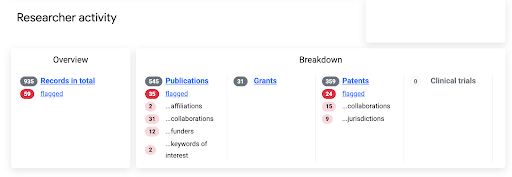“I can see any potential risks at a glance and then drill down into the specifics”
– Dr Melissa Bliss, Due Diligence and Compliance Officer, Queen Mary University of London
Dr Melissa Bliss is Due Diligence and Compliance Officer at Queen Mary University of London (QMUL), a leading research-intensive university with a high ranking for research quality. Her team is responsible for carrying out research security due diligence checks on the university’s international collaborations.
At a time of increased geopolitical instability and a global technology race, research organizations need to be ultra-alert to the risk of their research being stolen or misused.
“Our job is to prevent this, and to protect the university and its researchers,” explains Melissa. “So our due diligence process has three main pillars: we investigate the organization, the person and the project.”
The growing need for a trustworthy, time-saving solution
Melissa and her team have to carry out an extensive range of checks, from whether the person has any concerning collaborators – exploring international ties, affiliations, collaborations and funding, to whether the research is dual-use, with both civil and military applications.
They used to conduct these checks manually. “But doing that was extremely time-consuming,” remembers Melissa, “and prone to human error and inconsistency. We can’t afford to be slow or make mistakes, especially nowadays when the risks to research are increasing quite rapidly. We’re also under increasing pressure from governments and funders to evidence how we make our risk assessments. And we’re more likely to be audited, so our processes really have to be watertight and show that our decisions are based on solid evidence.”
Strengthening research security with Dimensions
That was why Melissa’s team started using Dimensions Research Security, a powerful application that protects against research security risk. The solution provides the full picture of international affiliations, collaborations, and funding relationships – critical for meeting evolving disclosure requirements. Research institutions can scrutinize data speedily but in detail, to evaluate risks before forming any collaborations.
“It’s incredibly useful and saves us a huge amount of time,” confirms Melissa. “After all, we do hundreds of due diligence checks a year. And we use Dimensions Research Security every day, because it’s absolutely designed for what my team do – which is to assess the risk of researchers in other organizations, as well as our own.”
Seeing a full picture of researcher risk
A Researcher Dashboard immediately summarizes the key points about them, from where they’re based and the years they’ve been active, to their publications and patents. If they’re flagged red, they’re higher risk – and Melissa can see the sources that were used to flag them.
“That transparency about sources is very valuable, because when we’re making risk assessments we can point directly to our evidence,” she says.
Melissa can then examine the researcher data from different viewpoints, such as their university affiliations over time, who they’ve been collaborating with in terms of publications, and the names of the co-authors they work with most often. Any red flags are clearly shown.

“It’s extremely useful to be able to see any potential risks at a glance and then drill down into the specifics,” enthuses Melissa. “Recently one of our academics wanted to work with a researcher in China on a project that looked very low risk. But then we saw that one of the researcher’s frequent collaborators was a guy who worked on missile technology, which changed the picture. Being able to investigate at this level of detail, quickly and easily, is vital to protecting our university’s reputation and making sure we comply with regulations.”
“Dimensions Research Security is absolutely designed for what my team do – which is to assess the risk of researchers in other organizations, as well as our own.”
An ever-changing landscape
Research risk is a constantly changing area, and universities are tasked with more obligations than ever before. “We’re having to justify collaborations at the micro level,” says Melissa. “And we need to be able to evidence how we make those assessments, because we get audited and reviewed not just by the government, but by the main UK funders as well.”
And more academic areas are starting to need stringent research security. Historically, humanities and social sciences have been at much lower risk than science, technology and medicine. But that’s now changing, says Melissa.
“The government has been less worried about humanities research, because what they’re really concerned about is tech transfer. So we tended to concentrate on spreading awareness within science, tech and medicine. But now we’re getting more AI projects in humanities and social sciences that could step into the area of export controls.
“The main thing is that Dimensions Research Security helps us identify which researchers are doing the higher-risk research, so we can make sure we talk to the right people.”
The need for greater awareness as risk increases
A real understanding of research risk is rare outside the specialist teams who handle it. With so much at stake, Melissa has spent considerable time and effort on helping researchers understand the risks and the need for security.
“This is a big culture change for academics,” she points out. “They often say: ‘But Melissa, I’ve been working with this person for a really long time. Why should I feel suspicious of them?’ So it’s good that we can use tools like Dimensions Research Security to help researchers understand where the risk might lie.”
As government directives increase, the burden on universities and researchers is growing. But Melissa makes one thing clear. “We’re absolutely not here to stop researchers doing research. We’re here to support them to do it safely, by identifying any risks in their collaborations and then seeing how we can mitigate them.”
Find out what Dimensions can do for you
Interested in how Dimensions can support your organization’s research security? Reach out to the team and unlock new efficiencies in compliance.
